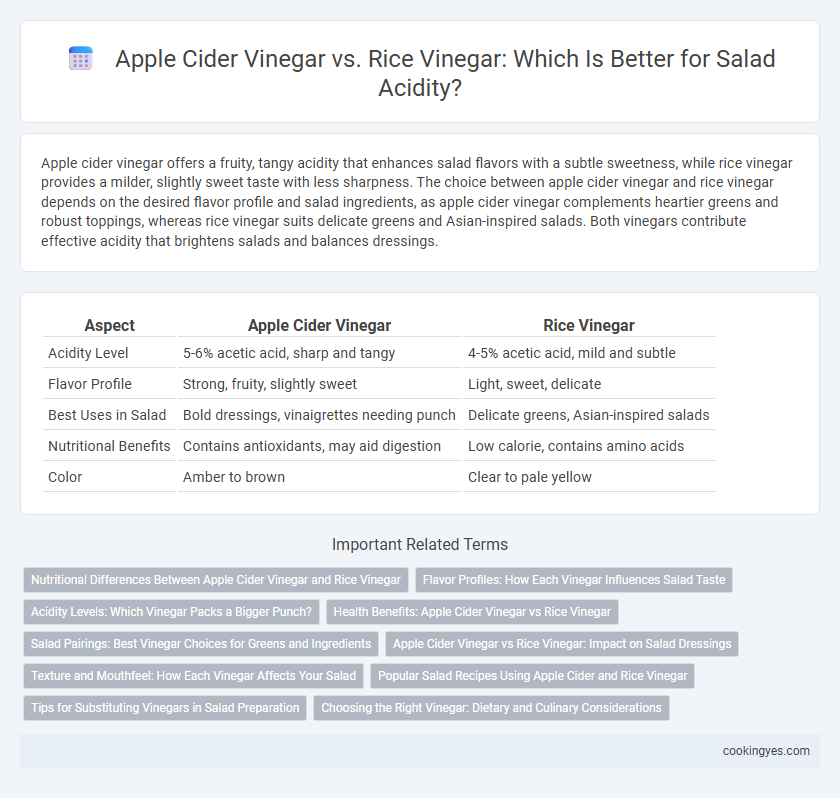Apple cider vinegar offers a fruity, tangy acidity that enhances salad flavors with a subtle sweetness, while rice vinegar provides a milder, slightly sweet taste with less sharpness. The choice between apple cider vinegar and rice vinegar depends on the desired flavor profile and salad ingredients, as apple cider vinegar complements heartier greens and robust toppings, whereas rice vinegar suits delicate greens and Asian-inspired salads. Both vinegars contribute effective acidity that brightens salads and balances dressings.
Table of Comparison
| Aspect | Apple Cider Vinegar | Rice Vinegar |
|---|---|---|
| Acidity Level | 5-6% acetic acid, sharp and tangy | 4-5% acetic acid, mild and subtle |
| Flavor Profile | Strong, fruity, slightly sweet | Light, sweet, delicate |
| Best Uses in Salad | Bold dressings, vinaigrettes needing punch | Delicate greens, Asian-inspired salads |
| Nutritional Benefits | Contains antioxidants, may aid digestion | Low calorie, contains amino acids |
| Color | Amber to brown | Clear to pale yellow |
Nutritional Differences Between Apple Cider Vinegar and Rice Vinegar
Apple cider vinegar contains acetic acid, malic acid, and small amounts of vitamins like B vitamins and vitamin C, contributing to its antioxidant properties and potential digestive benefits in salads. Rice vinegar, on the other hand, is lower in acetic acid and calories but contains amino acids and trace minerals that provide a milder flavor and can aid in metabolism. Both vinegars offer unique nutritional profiles, with apple cider vinegar promoting gut health through probiotics, while rice vinegar supports hydration and provides a subtler acidity ideal for light salad dressings.
Flavor Profiles: How Each Vinegar Influences Salad Taste
Apple cider vinegar imparts a robust, fruity tang to salads, enhancing sweetness while adding a subtle depth with its natural apple undertones. Rice vinegar offers a milder, slightly sweet flavor with a gentle acidity that preserves the freshness of salad ingredients without overpowering them. The choice between these vinegars depends on the desired balance of sharpness and subtlety, where apple cider vinegar suits bold, hearty salads and rice vinegar complements delicate, fresh greens.
Acidity Levels: Which Vinegar Packs a Bigger Punch?
Apple cider vinegar typically has an acidity level of around 5-6%, providing a sharp, robust tang that enhances salad dressings with a pronounced bite. Rice vinegar, with a milder acidity level ranging from 4-5%, offers a subtle, slightly sweet flavor that balances salads without overpowering other ingredients. For those seeking a stronger acidic punch, apple cider vinegar is the preferable choice, while rice vinegar serves well for delicate, nuanced dressings.
Health Benefits: Apple Cider Vinegar vs Rice Vinegar
Apple cider vinegar contains acetic acid and beneficial enzymes that may support digestion, blood sugar regulation, and antimicrobial activity, making it a popular choice for health-conscious salad dressings. Rice vinegar offers a milder acidity with lower acetic acid content and contains antioxidants such as amino acids and phenolic compounds, which can aid in reducing inflammation. Both vinegars contribute distinct health benefits, but apple cider vinegar is often preferred for its stronger potential in boosting metabolism and gut health.
Salad Pairings: Best Vinegar Choices for Greens and Ingredients
Apple cider vinegar offers a fruity, slightly sweet acidity that enhances heartier greens like kale and spinach, complementing ingredients such as nuts, apples, and sharp cheeses. Rice vinegar provides a milder, more delicate tang, making it ideal for lighter greens like arugula and butter lettuce, along with ingredients like cucumber, avocado, and sesame seeds. Choosing the right vinegar depends on balancing the vinegar's acidity and flavor profile with the texture and taste of the salad ingredients for optimal harmony.
Apple Cider Vinegar vs Rice Vinegar: Impact on Salad Dressings
Apple cider vinegar provides a tangy, fruity acidity that enhances salad dressings with a robust flavor and natural sweetness, aiding digestion and adding antioxidants. Rice vinegar offers a milder, slightly sweet taste with lower acidity, making it ideal for delicate salads or Asian-inspired dressings. Selecting between apple cider vinegar and rice vinegar impacts the dressing's flavor profile and acidity level, influencing the overall taste and texture of the salad.
Texture and Mouthfeel: How Each Vinegar Affects Your Salad
Apple cider vinegar imparts a bold, tangy acidity that enhances the crispness of leafy greens, contributing to a sharp, refreshing mouthfeel. Rice vinegar offers a milder, slightly sweet acidity that smooths the texture of vegetables, creating a gentle and balanced mouthfeel. The choice between these vinegars directly influences the salad's overall crunch and the harmony of flavors on the palate.
Popular Salad Recipes Using Apple Cider and Rice Vinegar
Apple cider vinegar enhances salad acidity with a fruity tang, commonly used in kale and spinach salads to complement sweet ingredients like apples and nuts. Rice vinegar offers a milder, slightly sweet flavor, perfect for Asian-inspired salads containing ingredients like sesame oil, soy sauce, and fresh vegetables. Popular salad recipes such as apple cider vinaigrette salad and sesame cucumber salad highlight the unique acidity profiles of each vinegar, balancing flavors and textures effectively.
Tips for Substituting Vinegars in Salad Preparation
When substituting apple cider vinegar for rice vinegar in salad preparation, consider that apple cider vinegar offers a stronger, tangier acidity with fruity notes compared to the mild, slightly sweet flavor of rice vinegar. Use slightly less apple cider vinegar to avoid overpowering the salad's balance, starting with a 1:1 ratio and adjusting to taste. Incorporate complementary ingredients like honey or sesame oil to mimic rice vinegar's subtle sweetness and enhance the overall flavor profile.
Choosing the Right Vinegar: Dietary and Culinary Considerations
Apple cider vinegar offers a robust, tangy flavor with potential health benefits like improved digestion and blood sugar regulation, making it ideal for heart-healthy or detox-focused salads. Rice vinegar provides a milder, slightly sweet taste that enhances delicate greens without overpowering, suitable for Asian-inspired or low-acidity dietary preferences. Selecting between these vinegars depends on the desired acidity level, flavor profile, and specific nutritional goals within the salad composition.
Apple cider vinegar vs rice vinegar for salad acidity Infographic

 cookingyes.com
cookingyes.com